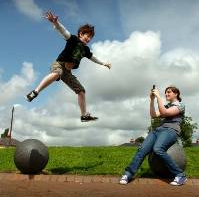More Lights to Dark City Spaces!
Welcome to Blitz Play Hero!Blitz-Light use interactive tags, circuit-bent electronics (in the shape of small trees) and Nintendo DS Light game consoles to create a live street concert of sound and light. The wireless network becomes activated by players (or
cyclists) carrying small sound-amplifiers on their belts
or which
can be fitting to a bicycle.The trees start of light up with bright coloured
LED lights when in contact with the RFID tag.

Based on the sequence of the RFID tag (
which works like a bar code) various sounds are generated on the DS light console. The numbers and sounds are then transferred to an online map which charts the players throughout the city. Great way to see your journey through the city!


There are 3 main game levels:
In LEVEL 1 players use the DS to “sniff” out open and closed WIFI hotspots. These are marked as playclouds (areas in the city where RFID tags can be placed). Players or cyclists chalk the symbol of a DS d-pad knob to indicate that a playcloud has been created. The location of the playclouds are stored on the DS as text file and is up-loaded to a Google map to store the data. This game data is overlayed on a map of the city with black and white polygons to represent players location.
The playclouds are assigned a base sound, used later in the concert, and at this point a player can view the map and begin to create a score of music, or simply use it to locate their nearest open WIFI spot.
LEVEL 2 invites players to find the playclouds and place RFID tags at their location. The system automatically assigns them a sound. This again is stored on the DS and transferred to the online map - updated with each tag.
LEVEL 3 is the live concert.
Players return to playclouds, scanning their own and other player’s tags, to play the sound on the DS. Each player becomes an instrument in the orchestra of RFID readers.
Throughout the levels players are awarded points for finding clouds, placing tags, and generating music, and thus the Blitz Play Hero is declared.
 The sandbox uses mobile phones and GPS technology to allow participation to document, record and write experiences in real-time and upload those files via video, SMS, sound and image directly from the mobile phone to a website to be shared with the all participants. Web-based projects provide a space for communities to utilised new social media tools to connect to others and be active author in promoting their values and local needs.
The sandbox uses mobile phones and GPS technology to allow participation to document, record and write experiences in real-time and upload those files via video, SMS, sound and image directly from the mobile phone to a website to be shared with the all participants. Web-based projects provide a space for communities to utilised new social media tools to connect to others and be active author in promoting their values and local needs.




















































